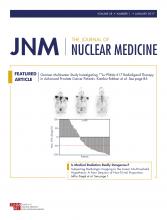TO THE EDITOR: We read with interest the study by Rauscher et al. reporting data about the short-axis diameter of prostate cancer lymph nodes detected by prostate-specific membrane antigen (PSMA) PET (1). The authors suggest that this imaging modality may be helpful for guiding salvage surgery (1). Such a paradigm is already being applied in radiation oncology, where noninvasive PET-guided salvage stereotactic body radiotherapy has entered routine clinical practice (2). Individual lymph nodes detected by choline or PSMA PET/CT can be irradiated in selected patients with oligometastatic prostate cancer. This avoids many of the risks associated with surgery, as well as the intraoperative challenge of locating a specific node. In keeping with Rauscher et al., our clinical impression was that the nodal metastases being detected with these scans were frequently under the 8- to 10-mm threshold in short-axis diameter used to identify nodes with a higher risk of being pathologic on conventional imaging (3). We therefore reviewed the plans of 46 PET-positive prostate cancer nodal metastases treated with salvage stereotactic body radiotherapy, 37 detected by choline and 9 by PSMA PET/CT. The median short axis on CT was 0.9 cm (range, 0.5–2.4 cm) for choline-detected nodes and 0.7 cm (range, 0.7–1.4 cm) for PSMA-detected nodes, with 10 of 37 (27%) and 24 of 37 (65%) choline-detected nodes and 5 of 9 (56%) and 7 of 9 (78%) PSMA-detected nodes having a short axis smaller than 8 and 10 mm, respectively. These results corroborate those of Rauscher et al. and indicate that nodal metastases identified by prostate cancer–specific PET imaging would frequently have been considered normal risk or low risk by size criteria alone (1). The median volume of choline- and PSMA-detected nodes was 1.3 cm3 (range, 0.4–12.6 cm3) and 0.6 cm3 (range, 0.4–1.7 cm3), respectively.
The authors mention the possibility of incorrectly allocating nodal fields in PET and surgical lymphadenectomy. Accurate targeting is also relevant in radiation oncology, especially when treating individual nodes as opposed to nodal regions. For example, if there are neighboring PET-negative nodes, it may not always be possible to differentiate the nodal metastasis on size or morphologic criteria. Therefore, coregistration of the diagnostic PET/CT scan with the radiotherapy-planning CT scan may be used to help identify the target node during treatment planning. In such situations it is important to verify the registration between the PET scan and the low-dose CT scan, to ensure that the region with enhanced uptake on PET corresponds to the correct node on CT and avoid possible misalignment of the PET and planning CT scans. A further challenge with small nodes can be good visualization on the imaging system (e.g., cone-beam CT) that is used to correctly position the node before irradiation. In our experience, if preset cone-beam CT options are not optimal, certain parameters (on the TrueBeam platform; Varian Medical Systems) may be adjusted by the user, improving image quality and facilitating accurate targeting.
Advances in diagnostic imaging are helping to drive new treatment options for patients and are enabling the detection of small metastases, with further reductions in the size threshold being likely (4). This is expected to present additional challenges to clinicians and to manufacturers of image-guided radiation therapy platforms that need to be able to accurately treat ever-smaller targets in the body.
DISCLOSURE
The Department of Radiation Oncology, VU University Medical Center, has research agreements with Varian Medical Systems. Ben Slotman and Max Dahele have received grants and personal fees from Varian Medical Systems outside the scope of this study. Ben Slotman (BrainLAB and ViewRay) and Max Dahele (BrainLAB) have received speaker honoraria outside the scope of this study. No other potential conflict of interest relevant to this article was reported.
Footnotes
Published online Aug. 18, 2016.
- © 2017 by the Society of Nuclear Medicine and Molecular Imaging.







